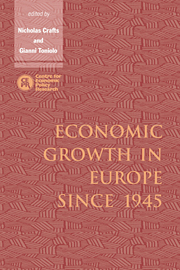Book contents
- Frontmatter
- Contents
- List of figures
- List of tables
- Preface
- List of contributors
- 1 Postwar growth: an overview
- 2 Institutions and economic growth: Europe after World War II
- 3 The varieties of Eurosclerosis: the rise and decline of nations since 1982
- 4 Why the 1950s and not the 1920s? Olsonian and non-Olsonian interpretations of two decades of German economic history
- 5 Convergence, competitiveness and the exchange rate
- 6 British economic growth since 1945: relative economic decline … and renaissance?
- 7 Economic growth in postwar Belgium
- 8 France, 1945–92
- 9 Economic growth and the Swedish model
- 10 Characteristics of economic growth in the Netherlands during the postwar period
- 11 Portuguese postwar growth: a global approach
- 12 Growth and macroeconomic performance in Spain, 1939–93
- 13 Irish economic growth, 1945–88
- 14 Italy
- 15 West German growth and institutions, 1945–90
- 16 An exercise in futility: East German economic growth and decline, 1945–89
- 17 Postwar growth of the Danish economy
- 18 Reflections on the country studies
- Index
12 - Growth and macroeconomic performance in Spain, 1939–93
Published online by Cambridge University Press: 04 August 2010
- Frontmatter
- Contents
- List of figures
- List of tables
- Preface
- List of contributors
- 1 Postwar growth: an overview
- 2 Institutions and economic growth: Europe after World War II
- 3 The varieties of Eurosclerosis: the rise and decline of nations since 1982
- 4 Why the 1950s and not the 1920s? Olsonian and non-Olsonian interpretations of two decades of German economic history
- 5 Convergence, competitiveness and the exchange rate
- 6 British economic growth since 1945: relative economic decline … and renaissance?
- 7 Economic growth in postwar Belgium
- 8 France, 1945–92
- 9 Economic growth and the Swedish model
- 10 Characteristics of economic growth in the Netherlands during the postwar period
- 11 Portuguese postwar growth: a global approach
- 12 Growth and macroeconomic performance in Spain, 1939–93
- 13 Irish economic growth, 1945–88
- 14 Italy
- 15 West German growth and institutions, 1945–90
- 16 An exercise in futility: East German economic growth and decline, 1945–89
- 17 Postwar growth of the Danish economy
- 18 Reflections on the country studies
- Index
Summary
Introduction
Spain's growth over the last four decades constitutes a distinctive case in postwar Western Europe. This was largely due to the acceleration of the 1960s and early 1970s, which could be partially attributed to delayed reconstruction. Before 1960, autarky was the rule and Spain's performance appears disappointing from a catching-up perspective, since its rate of growth fell short of the potential one implied by the country's backwardness. Two phases can be distinguished after Franco's death: one of economic retardation and political instability during the years of transition to democracy (1975–85), which coincided with the oil shocks; and another of return to fast growth after Spain became a member of the EC (1986), which ended with the recession of the early 1990s.
In this chapter, Spain's economic growth since the Civil War (1936–9) is assessed. After presenting trends in aggregate performance within a comparative growth accounting framework, institutional and macroeconomic features in the main postwar phases are explored as ultimate historical explanations for Spanish performance.
Spain's economic performance in the long run
After negligible growth in real GDP per head during the early nineteenth century, a sustained gain in product per head took place up to World War I (Table 12.1). New annual estimates emphasize the acceleration of growth between 1850 and 1890, particularly during the free-trading years (1860s to 1880s), and the slowdown that followed the tariff of 1891 and the suspension of the peseta's gold convertibility (Prados de la Escosura, forthcoming). The financial costs of the independence wars of Spain's last colonies (Cuba, Puerto Rico and the Philippines) also contributed to slackening economic growth.
- Type
- Chapter
- Information
- Economic Growth in Europe since 1945 , pp. 355 - 387Publisher: Cambridge University PressPrint publication year: 1996
- 16
- Cited by



